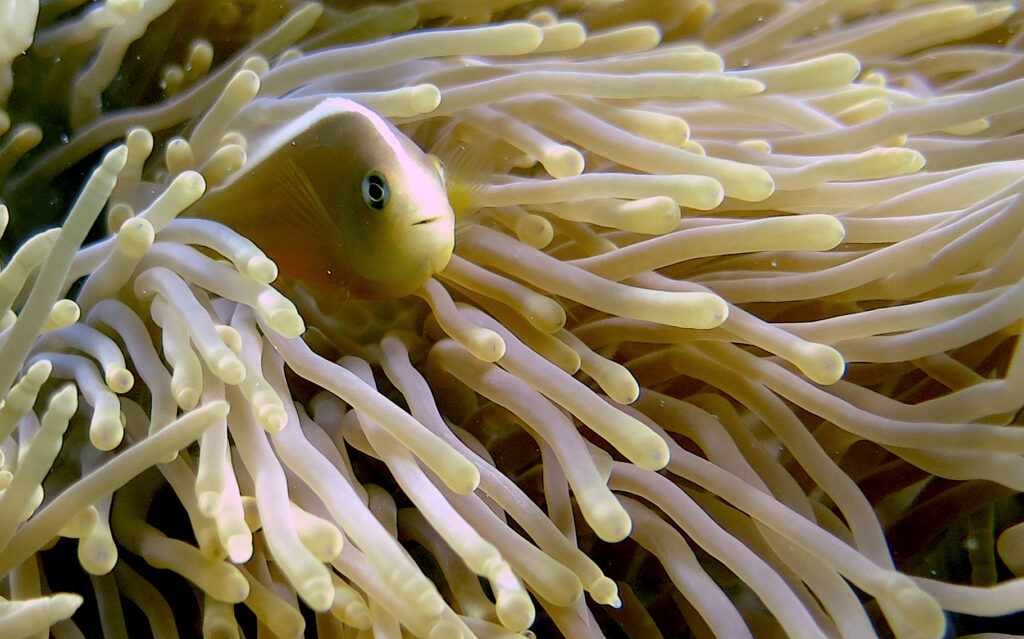CLIMATE CHANGE
- Anemone bleaching on juvenile anemonefish metabolic rate
Short-term study: We exposed juvenile anemonefish to unbleached and bleached anemones in a paired design over two weeks and found that their metabolic rate, i.e. their energy expenditure, was elevated in bleached anemones (Norin et al., Proc Roy Soc Lond B, 2018). Juveniles would need to compensate for this higher metabolism with increased foraging - the question is can they and do they?

Longer-term study: As bleaching can last up to several months (e.g. 9 months!) in the wild, we conducted a second experiment with the aim of understanding the effect of exposure to bleached anemones for several months and its potential cascading effects on anemonefish to see if anemonefish can acclimatise, i.e. get used to this disturbance. We found that contrary to predictions, juvenile anemonefish do not acclimatise (Cortese et al., Functional Ecology 2021). Fish living in bleached anemones for a longer period of time progressively decrease their metabolism without any sign of acclimation, they also reduce their growth and change their behaviour, spending less time between the anemone tentacles and becoming less active.

- Thermal stressors and bleaching on adult anemonefish stress response and reproduction *published in Nature Communications*
We monitored breeding anemonefish in their anemones in the lagoon of Moorea over 15 months before, during and after the predicted El Nino warming event in 2016. Half of the anemones hosting our monitored anemonefish bleached - a natural field experiment. Whilst temperature alone didn't impact anemonefish steroid hormones or reproduction, bleaching did (Beldade et al 2017).


Male and female anemonefish living in bleached anemone still had elevated cortisol levels after 3 months, 11-ketotesterone levels and estradiol levels plummeted and reproduction stopped (Beldade et al 2017). Fortunately when the warming event ended and the anemones had recovered so did the anemonefish and reproduction returned to normal.
- Thermal stressors on a coral reef fish's stress response
We visited the Iles Eparses in the Mozambique Channel on the Marion Dufresne and measured the cortisol response of skunk anemonefish, Amphiprion akallopisos, to a generic stressor. Reef populations on these islands are rarely exposed to any anthropogenic stressors, but have experienced different thermal histories over the last 15 years. We found that those fish populations exposed to higher maximum sea surface temperatures showed greater cortisol responses to a generic stressor. We suggest that the stress-responses axis could have been permanently modified following a thermal stressors event. Such a modification could be adaptive if repeated thermal stress events were common within a reef organism's lifetime (Mills et al., 2015).

- Ocean acidification and thermal stressors
We are working on the effects of both ocean acidification and thermal stress on embyronic development in the sea hare, Stylocheilus striatus.
An elevated thermal environment accelerates planktotrophic development of this important benthic invertebrate, possibly at the cost of reducing fitness and increasing mortality (Horwitz et al., 2017). In collaboration with Eric Armstrong and Jonathan Stillman we have also found that oceanic conditions congruent with climate change predictions for the end of the twenty-first century suppress successful development in S. striatus embryos, potentially reducing their viability as pelagic larvae (Armstrong et al, 2017).
However, we recently found evidence of beneficial developmental plasticity in sea hares, S. striatus, that developed as newly settling recruits under warmer conditions or ocean acidification, compared to individuals exposed when they were already adults. But plasticity may not be enough to cope with the combined increase in acidification and temperature (Horwitz et al., 2020)...
We are also evaluating whether developmental /or transgenerational acclimation by Stylocheilus striatus, to the combined stressors will mitigate the effects on embyronic development.
BOAT NOISE POLLUTION
In collaboration with Sophie Nedelec, Andy Radford and Steve Simpson from the Universities of Bristol and Exeter in the UK, we investigated the effects of boat noise pollution on development, physiology and behaviour and whether marine organisms can habituate to boat noise.
- Embryonic development in the opistobranch, Stylocheilus striatus.
Boat noise playback reduced successful development of embyros and increased the mortality of recently hatched larvae (Holles et al., 2014).
- Habituation in juvenile and adult reef fish
Repeated exposure of boat noise playback to juvenile damselfish, Dascyllus trimaculatus, over three weeks revealed physiological habituation (Nedelec et al., 2017). In addition, a comparison of short- and long-term exposure of boat noise playback to adult clownfish, Amphiprion chrysopterus, suggests behavioural, but not hormonal habituation (Mills et al., in prep).
In collaboration with Isabelle Côté, from Simon Fraser University, our "dream team" found that boat passage affects the honesty of the interactions between cleanerfish and their clients, despite cheating more, cleanerfish are not punished correspondingly (Nedelec et al., 2017).
Loving this cartoon that Hakai Magazine made from our paper!
TOURISM
In collaboration with Johann Mourier and Serge Planes and their work on shark populations in the Pacific, we are investigating the effects of tourism on their hormones and metabolism.
- Impacts of ray- and shark-feeding on sharks
Effects of ray- and shark-feeding on the growth, reproduction and metabolism of the blacktip reef shark Carcharhinus melanopterus was investigated in Moorea (Mills et al., 2010; Mourier et al., 2013; Mills et al., in prep).




